What happened with kittiwakes in Tromsø in 2025?
- Roel Melman & Delphin Ruché

- Sep 16
- 14 min read
Updated: Sep 22
It has been a busy summer for the Kittiwalkers, who monitored kittiwakes and rescued chicks in Tromsø city center and Skattøra. As kittiwakes have now left Tromsø, it is time to report!
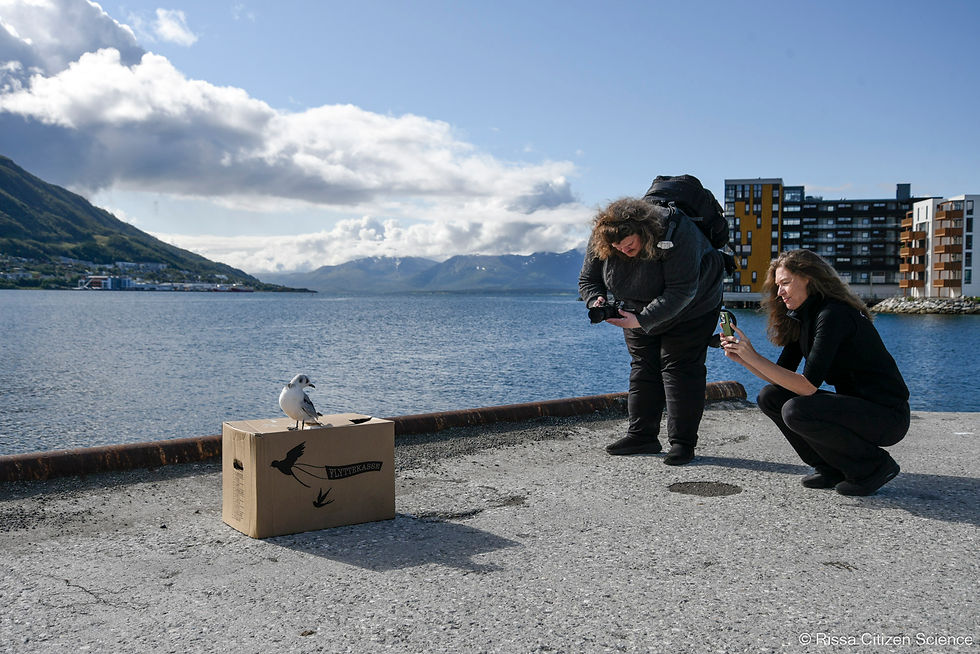
Two Kittiwalkers release chick Dora on August 21.
If you want to directly jump to one chapter:

Kittiwake hotels at Muséparken in summer 2025.
The Rissa Citizen Science mobile app
The launch of the Rissa Citizen Science app on both the App Store and Google Play has been a real game-changer for the Kittiwalkers this year. In the past, we relied on Microsoft and later Google Forms to record observations, but both came with their own limitations. Thanks to the fantastic work of our app developer, Philip Redecker, we now have a tailor-made tool for monitoring Tromsø’s breeding kittiwakes, and we couldn’t be more grateful.
A special shout-out goes to Roel Melman, who has been instrumental in developing automated analyses of our database. Thanks to him, we were able to avoid data gaps and coordinate our efforts more efficiently. His contribution has made our monitoring efforts smoother and more impactful.

Two Kittiwalkers use the Rissa app to record their observations in Tromsø city center in June 2025.
Record participation
Between April 11 and August 31, 57 people downloaded the app and together made an impressive 1,615 submissions from Tromsø’s city center and Skattøra. That’s double the number of submissions compared to the same period last year (Figure 1).
What do we mean by "submission", "station", "unit" and "nest"?
Figure 1: Number of submissions on the Rissa Citizen Science's app for the hotels and the city stations (by Roel Melman).
The kittiwake hotels also saw a big jump in attention: from around 100 submissions in 2024 to over 600 submissions in 2025 (Figure 1).
These numbers highlight not only a remarkable level of community engagement, but also the growing curiosity and care for Tromsø’s kittiwakes.
At the end of the nesting season, 33 members were on the Kittiwalkers WhatsApp group, sharing updates with each other, asking questions, reporting suspicious behaviors or calling for help when a chick was found on the ground.
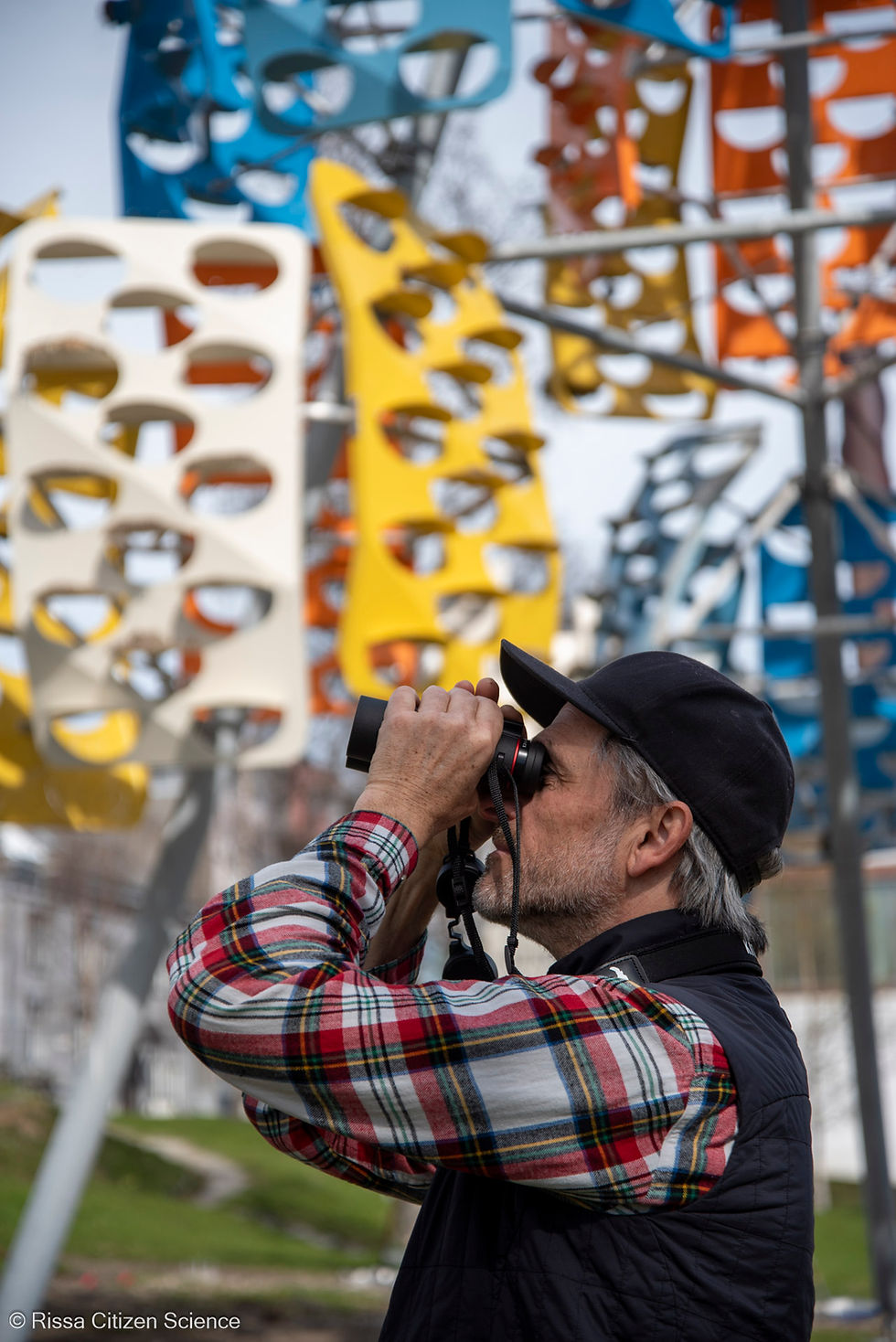
A Kittiwalker monitoring the Kittiwake hotels in May 2025.
More outreach and dissemination
The high level of engagement is also due to Rissa Citizen Science’s communication effort.
66 participants joined the 4 workshops that Rissa Citizen Science organized in Tromsø city center to train new Kittiwalkers between May 14 and July 8.

Volunteers joining one of the workshops aiming at training future Kittiwalkers on May 22.
Between April 11 and August 31, we published 26 articles about kittiwakes on Rissa's blog. We posted almost 40 kittiwake-related reels on Instagram and Facebook, and regular posts on LinkedIn.
Local newspapers iTromsø and Ságat published articles about Rissa's work on kittiwakers in April 2025.
145 people attended 4 presentations at Tromsø Museum for Birdlife Troms, Havforskningsinstituttet (Institute of Marine Research), at Kunstforening (Tromsø Center for Contemporary art) for the Polar Film Lab, and at Kafé Fint for Pint of Science.

Rissa's director Delphin Ruché presenting at Arctic Frontiers Science for Schools in January 2025.
We also organized 2 kittiwalks with 15 travelers from cruise ships. These initiatives are part of Rissa Citizen Science’s efforts to encourage a more regenerative form of tourism in Tromsø and Senja, one that leaves a positive impact on nature and host communities.
Filmmaker Antoine Tribotté realized a short documentary about Rissa's work on kittiwakes in Tromsø "Kittiwakes: A Symbol of Coexistence":
Where are kittiwakes in Tromsø city center?
Kittiwalkers patrolled the city center from April 12 to August 31, and mapped kittiwake nests. The map was updated every time a new station was found, with the last update made on June 25. After that, we can consider that in the city center, all the nests visible from the street, were known and mapped.

Kittiwake nesting in Tromsø city center in summer 2025.
In Tromsø’s city center, kittiwake nests are spread across five zones along the seashore (Figure 2). In the southernmost zone, which includes Muséparken and Fylkeshuset, nearly half of these nests were located on the kittiwake hotels.

Figure 2: Map of the stations (kittiwake nests) recorded by the Kittiwalkers in Tromsø city center on July 31, 2025 (by Roel Melman).
How many kittiwakes were in Tromsø city center in 2025?
On July 31 (when the first chicks started flying), the Kittiwalkers recorded 221 nests with at least one chick.
In 2025, the number of adult kittiwakes observed by the Kittiwalkers at the stations mapped in Tromsø city center was significantly higher than in previous years (Figure 3). This suggests that new kittiwakes kept coming to Tromsø, confirming the trend observed in the previous years, and the fact that Tromsø is perceived as a refuge for this endangered species.

Figure 3: Adult kittiwakes and apparently occupied nests recorded by the Kittiwalkers in Tromsø city center in 2025 (by Roel Melman).
This sharp increase in the number of adults kittiwakes is also a consequence of the destruction of the “Mack Øst colony” (150 pairs) and of the two kittiwake hotels at Strandvegen 8 (100 pairs), since they were not included in the Kittiwalkers monitoring last year.

Demolition in spring 2025 of the Mack building, which hosted around 150 pairs of kittiwakes in 2024.
How many kittiwakes in Skattøra in 2025?
Skattøra is an industrial zone located near the northern tip of Tromsø island. There are three separate colonies on cliffs (Figure 4) and one colony on a floating dock. The Kittiwalkers monitored the cliffs only. A telescope would be necessary to monitor the floating dock effectively, but Rissa Citizen Science unfortunately doesn’t have one.

Figure 4: Map of the kittiwake colonies in Skattøra in 2025 (the floating dock is not included on this map) (by Roel Melman).
On Cliff 1, the number of active nests mid-July was 12. A spectacular drop compared to 2024, since 128 pairs bred on Cliff 1 last year, according to NINA ornithologists Karl-Otto Jacobsen and Tone Reiertsen. This collapse does not come as a surprise, since most of the cliff was covered with a net last winter.
On Cliff 2, the colony was very active in May and June, until it suddenly was totally and permanently deserted in the middle of the breeding season. After this desertion, the number of kittiwakes on Cliff 3 increased significantly, which suggests a relocation of the pairs after a traumatic and unidentified event on Cliff 2. According to NINA ornithologists, 84 pairs used this cliff in 2024.
Cliff 3 hosted the largest colony of the three sites this year. Over 50 nests with at least one chick were recorded mid-July by the Kittiwalkers. However, on August 16, part of the cliff was covered with a net. Chicks were still sitting in the cliff at the time. There is not available data from previous years, since the Kittiwalkers were the first to document this site in 2025.

Figure 5: Kittiwake population in Skattøra in 2025 (by Roel Melman).
Skattøra is a vital yet underappreciated site for the survival of the endangered kittiwake in Tromsø. Installing hotels here is an urgent measure, not only to replace destroyed nesting sites, but also to prevent future conflicts when kittiwakes inevitably seek out new areas to colonize. Acting now offers an unique opportunity to safeguard the species while reducing tension with residents and workers.

Kittiwake nesting in Skattøra in July 2025.
The kittiwake hotels
Kittiwake hotels offer alternative nesting sites for kittiwakes in Tromsø and help reduce conflict with this endangered species. Developed through collaboration between Tromsø municipality, architects, artists, and scientists, they represent a concrete solution that makes coexistence more achievable.

Figure 6: breeding success at the kittiwake hotels in 2025. The number above the column corresponds to the number of successful nests, i.e. nests that produced at least one chick (by Roel Melman).
Muséparken
In Muséparken, 2 tripod-shaped kittiwake hotels were removed, and one new hotel (Hotel 5) was put up at the start of the year. The colorful structure has 460 ledges: it is by far the largest kittiwake hotel in Tromsø. The upper ledges were quickly adopted by kittiwakes, and 5 nests produced chicks this year (Figure 6). Considering that it takes kittiwakes some time to establish a colony on a new site, the presence of many adults on Hotel 5, and these 5 successful nests are a promising sign for the years to come!

Kittiwake Hotel 5 in Muséparken in June 2025.
The Muséparken kittiwake hotels, and particularly Hotel 3, play a vital role in the conservation of kittiwakes in Tromsø. They have also become a local landmark, attracting the attention of both residents and tourists, and people waiting at the Polaria bus stop. From an outreach perspective, their location is ideal for raising awareness about kittiwakes in Tromsø.

Hotel 3 is the most successful kittiwake hotel in Tromsø so far.
Fylkeshuset
The two hotels (Hotels 8 and 9) were modified before the 2025 nesting season, and this proved to be effective. While they had not been used at all in 2024, they were visited by many kittiwakes this year, and 7 nests produced chicks (Figure 6). Some pairs built a nest and did not produce chicks, but this is often the case in new colonies where birds are more stressed and vulnerable to predation than in large established colonies. The Fylkeshuset building was still hosting a large kittiwake colony, and these two hotels represent a strategic alternative if one day the building was to be covered with effective bird deterrents.
Ideally, additional ledges should be added to Hotels 8 and 9 before the next nesting season, to offer alternative nesting sites to the kittiwakes currently on the Fylkeshuset building.

Kittiwakes nesting on the Fylksehuset Kittiwake hotels. July 2025.
Mack Øst hotels
These two hotels were meant to compensate for the destruction of the Mack Øst colony after the demolition of the Mack building. In fact, this compensatory measure was a condition for the demolition to proceed. About 150 nests were recorded on the Mack building in 2024, and the two hotels provide between 280 and 320 potential nesting spots.

The Mack Øst kittiwake hotels in March 2025.
The operation started off well, with kittiwakes quickly showing interest in the new hotels. However, once the hotels were moved outside the construction site fence, they ended up directly in the pathway used by people walking along the waterfront. The constant flow of pedestrians, bicycles, and dogs proved incompatible with a kittiwake colony. The hotels were also too low, and people sometimes passed beneath them to get a closer look. Kittiwalkers monitoring the site observed clear signs of stress, as the birds frequently took off or displayed restless behavior in response to the proximity with humans.

The Mack Øst kittiwake hotels before they were moved outside the construction site fence, in May 2025.
After waiting several weeks for the contractor to install a fence to reduce disturbance, we finally took the initiative one windy Sunday morning, setting up a temporary barrier with barrels and rope. Immediately, the kittiwakes returned. The Kittiwalkers soon recorded a few active nests. But since it was already late in the breeding season, the non-breeding birds gradually spent less and less time at the site, leaving the breeding pairs increasingly vulnerable to stress and predation. One by one, the nests failed, and in the end, no chicks were raised there.

One of the Mack Øst kittiwake hotels that was abandoned by the birds due to disturbance (May 2024).
On a positive note, once the hotels were protected by the improvised fence, kittiwakes showed clear interest in them. The sea-facing side was used almost exclusively, while the land-facing side remained largely vacant. If these hotels stay where they are and are protected by a fence, it is likely that they will be used by kittiwakes next year.
It is important to leave a larger space between the sea and the hotels, so that falling chicks don’t fall in the sea, and instead can be picked and rescued.
Kittiwakes returned on the Mack Øst hotels after they were protected by an improvised fence.
Strandvegen 8
The dismantling of these two hotels by Tromsø municipality resulted in the loss of around 100 breeding pairs. In the first half of the 2025 season, many kittiwakes stayed on the roof of Strandvegen 8, where the hotels once stood, without starting breeding. Others relocated to several sides of the building itself, to the Framsenteret, and to nearby buildings. These expected relocations fueled hostility toward the species. This setback was highlighted in a Nordlys article on June 22, which reported an incident where someone was caught destroying nests on their windowsill.
Reinstalling the two hotels at this site would help concentrate kittiwakes in a more suitable location and reduce potential conflicts.
The Strandvegen 8 kittiwake hotels in 2023 and 2024 when they hosted abot 100 breeding pairs of kittiwakes.
Kittiwakes need stable nesting sites
Observations across Norway suggest that food availability was limited for kittiwakes this year during the breeding season. But the low breeding success that we observed in Tromsø is not a proof of low food availability, because in the city, kittiwakes face other challenges.
For example, it is impossible to dissociate the effect of food availability, nest availability, and disturbances on the kittiwakes' breeding success. In Tromsø city center, hotels 3 and 4 in Muséparken are one of the rare places where kittiwakes were not disturbed in 2024 and in 2025. Or relatively, since these two hotels were moved after the 2024 breeding season, and hotel 4 was moved closer to a tree, which kittiwakes typically find repulsive.
Even if the repelling effect of placing hotel 4 near a tree hasn’t been proven, the distance between future kittiwake hotels and nearby trees should be given more careful consideration in the coming years.
On hotel 3, the number of nests with at least one chick remained the same in 2024 and 2025. This suggests that undisturbed colonies tend to perform better than disturbed, late-starting, or newly established colonies.
On this same hotel 3, the number of nests with only one chick was higher in 2025 than 2024, while the number of nests with 2 chicks was lower. This may be a consequence of the low food availability mentioned earlier.

Figure 7: Number of nests with chicks on the Muséparken hotels in 2025 (by Roel Melman).
For this figure, the number of nests is estimated using only those with visible chicks. In other words, only nests where chicks could be seen are included in the count. The figure shows the maximum number of such nests observed at any point during the monitoring period, based on individual submissions.
The main threats to kittiwakes in Tromsø in 2025
Effective bird deterrents
Almost all the spikes that can potentially harm kittiwakes have now been removed in Tromsø. Building and business owners have moved towards more effective deterrents, such as slanted boards and nets. In one of the meetings initiated by Rissa Citizen Science with building owners, one of them agreed to test a new type of deterrent that is harmless to birds, but it proved relatively ineffective and there will be a follow up before the end of the year.

An example of an effective kittiwake detterent in Tromsø city center.
Demolition of the Mack building
With 150 pairs lost, the compensatory measure (the two hotels) failed to provide an immediate alternative for the displaced birds. This year, no chicks were produced at the Mack Øst kittiwake hotels. However, the structures remain a promising solution for the future, as kittiwakes clearly show interest in them once protected by a fence that minimizes disturbance.
Destruction of two successful kittiwake hotels
With the loss of approximately 100 breeding pairs following the dismantling of the two kittiwake hotels at Strandvegen 8, we respectfully urge Tromsø Municipality to revisit its previous decision and prioritize the reinstatement of kittiwake hotels in this area. Such action is essential to support the conservation of this endangered species and to promote sustainable coexistence within the city.
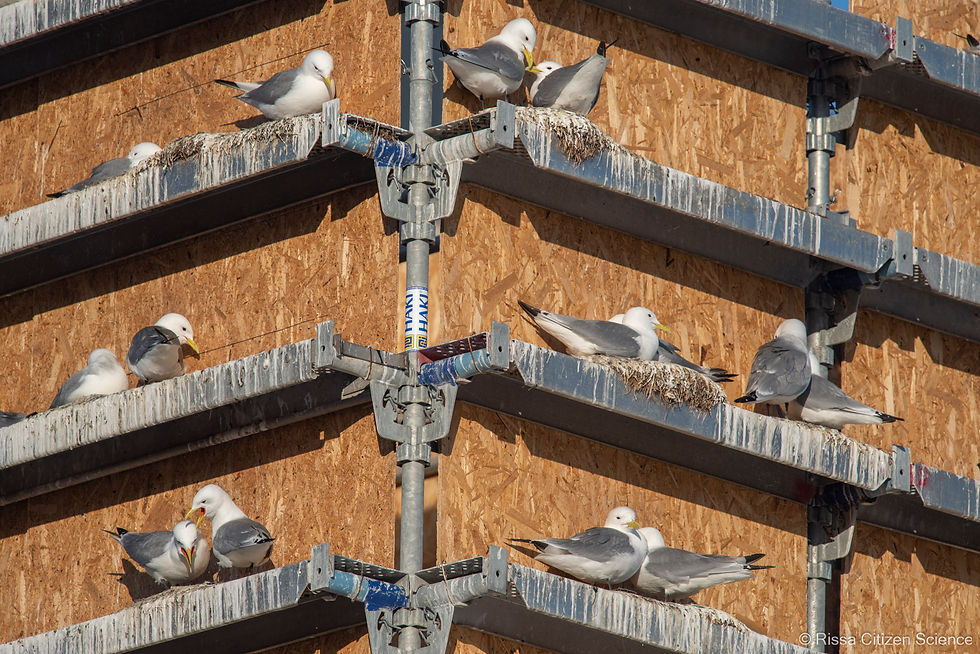
One of the kittiwake hotels at Strandvegen 8 in 2024.
Predation by crows in Muséparken and Fylkeshuset
The Kittiwalkers observed intense predation by crows on kittiwake chicks in this area. Naima monitored the nests around Fylkeshuset almost daily throughout the breeding season, describing the site as a "kittiwake graveyard". Despite arriving as early as 6 AM, she often found chicks already partly eaten or fatally injured. On one occasion, a crow was seen taking a chick directly from a nest. It is also likely that crows killed chicks that had fallen to the ground before they could fly.
Unused kittiwake hotels
Over the summer, two tripod-shaped hotels remained standing near Strandvegen 8. These had previously been located in Muséparken. Despite meetings and discussions with the municipality (and suggestions to relocate them to Skattøra) the tripods remained unused this summer.
We hope that the hotels can be redeployed before the next nesting season, either at Strandvegen 8 or at Skattøra, where they are most urgently needed.

The two unused kittiwake hotels near Strandvegen 8 in spring 2025.
Deployment of nets on cliffs
Of the three cliffs used by kittiwakes in Skattøra this year, two are now partly covered with nets. The third cliff was suddenly abandoned due to a traumatic, unidentified event. Unlike the colonies in the city center, the kittiwakes at Skattøra receive little attention, despite the site being of critical conservation importance.
To safeguard the pairs whose nests are now covered with netting, alternative breeding sites such as kittiwake hotels must be established in suitable locations at Skattøra before the kittiwakes return in 2026.

A pair of kittiwakes on their nest, now under a net, inaccessible. Skattøra, April 2025.
Low food availability
While it is too early to confirm with scientific sources, field observations from several sites along the Norwegian coast suggest that food availability was limited during the nesting season. Such scarcity can have a significant impact on the breeding success of kittiwakes. In Tromsø, reduced food supply would add yet another layer of stress to birds already struggling with limited nesting sites, nest destruction, high predation, frequent disturbances, and disease.
Avian influenza
The disease was confirmed in Tromsø before mid-August, when most of the chicks had already left their nest. Several kittiwake chicks were found on the ground, showing symptoms of avian influenza. Other birds were found dead and not eaten, including crows, ducks and herring gulls.
Kittiwake chicks rescued and live cam
Between the July 20 and August 11, we rescued 15 kittiwake chicks. Out of these, 11 were found in Skattøra by Julian, who is by far the number one kittiwake rescuer in Tromsø this year! Daniel, Matthew, Ingrid and Naima found the remaining 4 others: one on top of the island, one near Muséparken and two in the city center. Out of these 15 rescued kittiwake chicks, 10 were released and 5 had to be euthanized or died soon after being rescued. Unlike last year, we were unable to get hold of rings to mark the chicks we released.

Dora was everyone's favorite. A strong personality, curious and always eager to explore her surroundings.
We received fish donations from a dozen generous people, and regular help to feed the chicks, which was done 5 to 6 times a day. Many thanks to Julian who was particularly involved in feeding the chicks.
Between August 8 and 22, we live-streamed rescued kittiwake chicks on YouTube, a first in Tromsø. The initiative aimed to foster empathy for this endangered species and promote coexistence. We are telling the story about the live cam in this short article.
Feeding time for Dora (who was always exploring), Mambo (the 5th rescue), Dumpling (extremely cute) and Ghandi (who thought he could live without eating).
Sparebankstiftelsen SpareBank 1 Nord-Norge and Birdlife Troms have supported our work with kittiwakes in Tromsø this year. We were able to lend binoculars to the Kittiwalkers thanks to a generous support from Focus Nordic. We are deeply grateful to Maren Hansen for her help in fine-tuning the Norwegian version of this article.
What do we mean by "submission", "station", "unit" and "nest"?
In the city center and at Skattøra:
A submission corresponds to an updated observation regarding the number of visible adults and of apparently occupied nests at one given station. A station is a location (typically, a building) used by kittiwakes during the breeding season. A station has at least one nest active at one point during the current year. An active nest is a nest used by a pair of kittiwakes, independently of their breeding success.
At the hotels:
A submission corresponds to updated observations of a given unit regarding the breeding status of every potential ledge (either empty, in use but empty, apparently occupied nest, or with1, 2 or 3 chicks). What is defined as a unit varies between hotels. For example, hotels 3, 4, 8 and 9 each form a whole unit, while hotels 5, 6 and 7 are composed of several units, to facilitate their monitoring by the Kittiwalkers.

Kittiwake Hotel 5, and its 7 units: 3 unites on 1st floor, 3 units on 2d floor and 1 unit at the top.

















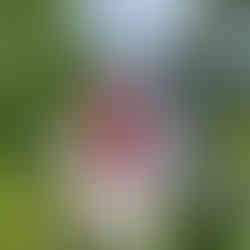




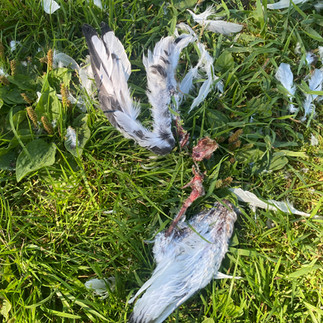
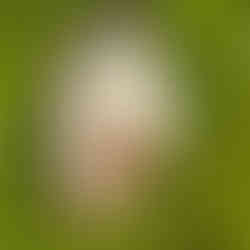








Comments